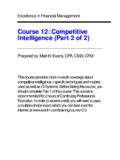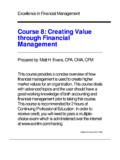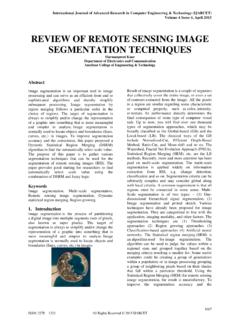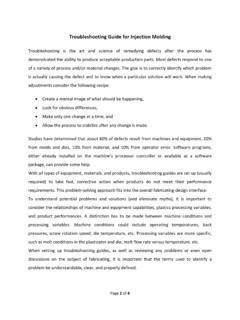Transcription of Course 7: Mergers & Acquisitions (Part 1) - exinfm
1 Course 7: Mergers & Course 7: Mergers & Course 7: Mergers & Course 7: Mergers & Acquisitions ( part 1) Acquisitions ( part 1) Acquisitions ( part 1) Acquisitions ( part 1)Prepared by: Matt H. Evans, CPA, CMA, CFMThis Course ( part 1) provides a concise overview of themerger and acquisition process, including the legalprocess, federal regulations and due diligence. Thepurpose of the Course is to give the user a solidunderstanding of how Mergers and Acquisitions work. Thiscourse is recommended for 2 hours of ContinuingProfessional Education. In order to receive credit, you willneed to pass a multiple choice exam which isadministered over the internet at March 2000 Excellence in Financial ManagementBasic ConceptsMergers and Acquisitions represent the ultimate in change for a business.
2 No other event ismore difficult, challenging, or chaotic as a merger and acquisition . It is imperative thateveryone involved in the process has a clear understanding of how the process this short Course will provide you with a better appreciation of what is might be asking yourself, why do I need to learn the merger and acquisition (M & A)process? Well for starters, Mergers and Acquisitions are now a normal way of life within thebusiness world. In today's global, competitive environment, Mergers are sometimes the onlymeans for long-term survival. In other cases, such as Cisco Systems, Mergers are a strategiccomponent for generating long-term growth.
3 Additionally, many entrepreneurs no longer buildcompanies for the long-term; they build companies for the short-term, hoping to sell thecompany for huge profits. In her book The Art of Merger and acquisition Integration,Alexandra Reed Lajoux puts it best:Virtually every major company in the United States today has experienced a majoracquisition at some point in history. And at any given time, thousands of thesecompanies are adjusting to post-merger reality. For example, so far in the decade ofthe 1990's (through June 1997), 96,020 companies have come under new ownershipworldwide in deals worth a total of $ trillion - and that's just counting acquisitionsvalued at $ 5 million and over.
4 Add to this the many smaller companies and nonprofitand governmental entities that experience Mergers every year, and the M & Auniverse becomes large & A DefinedWhen we use the term "merger", we are referring to the merging of two companies whereone new company will continue to exist. The term " acquisition " refers to the acquisition ofassets by one company from another company. In an acquisition , both companies maycontinue to exist. However, throughout this Course we will loosely refer to Mergers andacquisitions ( M & A ) as a business transaction where one company acquires anothercompany.
5 The acquiring company will remain in business and the acquired company (whichwe will sometimes call the Target Company) will be integrated into the acquiring companyand thus, the acquired company ceases to exist after the can be categorized as follows:Horizontal: Two firms are merged across similar products or services. Horizontal Mergers areoften used as a way for a company to increase its market share by merging with a competingcompany. For example, the merger between Exxon and Mobil will allow both companies alarger share of the oil and gas : Two firms are merged along the value-chain, such as a manufacturer merging witha supplier. Vertical Mergers are often used as a way to gain a competitive advantage withinthe marketplace.
6 For example, Merck, a large manufacturer of pharmaceuticals, merged withMedco, a large distributor of pharmaceuticals, in order to gain an advantage in distributing : Two firms in completely different industries merge, such as a gas pipelinecompany merging with a high technology company. Conglomerates are usually used as away to smooth out wide fluctuations in earnings and provide more consistency in long-termgrowth. Typically, companies in mature industries with poor prospects for growth will seek todiversify their businesses through Mergers and Acquisitions . For example, General Electric(GE) has diversified its businesses through Mergers and Acquisitions , allowing GE to get intonew areas like financial services and television for M & AEvery merger has its own unique reasons why the combining of two companies is a goodbusiness decision.
7 The underlying principle behind Mergers and Acquisitions ( M & A ) issimple: 2 + 2 = 5. The value of Company A is $ 2 billion and the value of Company B is $ 2billion, but when we merge the two companies together, we have a total value of $ 5 joining or merging of the two companies creates additional value which we call "synergy" value can take three forms:1. Revenues: By combining the two companies, we will realize higher revenues then if thetwo companies operate Expenses: By combining the two companies, we will realize lower expenses then if thetwo companies operate Cost of Capital: By combining the two companies, we will experience a lower overall costof the most part , the biggest source of synergy value is lower expenses.
8 Many Mergers aredriven by the need to cut costs. Cost savings often come from the elimination of redundantservices, such as Human Resources, Accounting, Information Technology, etc. However,the best Mergers seem to have strategic reasons for the business combination. Thesestrategic reasons include:! Positioning - Taking advantage of future opportunities that can be exploited when the twocompanies are combined. For example, a telecommunications company might improveits position for the future if it were to own a broad band service company. Companiesneed to position themselves to take advantage of emerging trends in the marketplace.
9 ! Gap Filling - One company may have a major weakness (such as poor distribution)whereas the other company has some significant strength. By combining the twocompanies, each company fills-in strategic gaps that are essential for long-term ! Organizational Competencies - Acquiring human resources and intellectual capital canhelp improve innovative thinking and development within the company.! Broader Market Access - Acquiring a foreign company can give a company quick accessto emerging global can also be driven by basic business reasons, such as:! Bargain Purchase - It may be cheaper to acquire another company then to investinternally.
10 For example, suppose a company is considering expansion of fabricationfacilities. Another company has very similar facilities that are idle. It may be cheaper tojust acquire the company with the unused facilities then to go out and build new facilitieson your own.! Diversification - It may be necessary to smooth-out earnings and achieve more consistentlong-term growth and profitability. This is particularly true for companies in very matureindustries where future growth is unlikely. It should be noted that traditional financialmanagement does not always support diversification through Mergers and Acquisitions . Itis widely held that investors are in the best position to diversify, not the management ofcompanies since managing a steel company is not the same as running a softwarecompany.
















